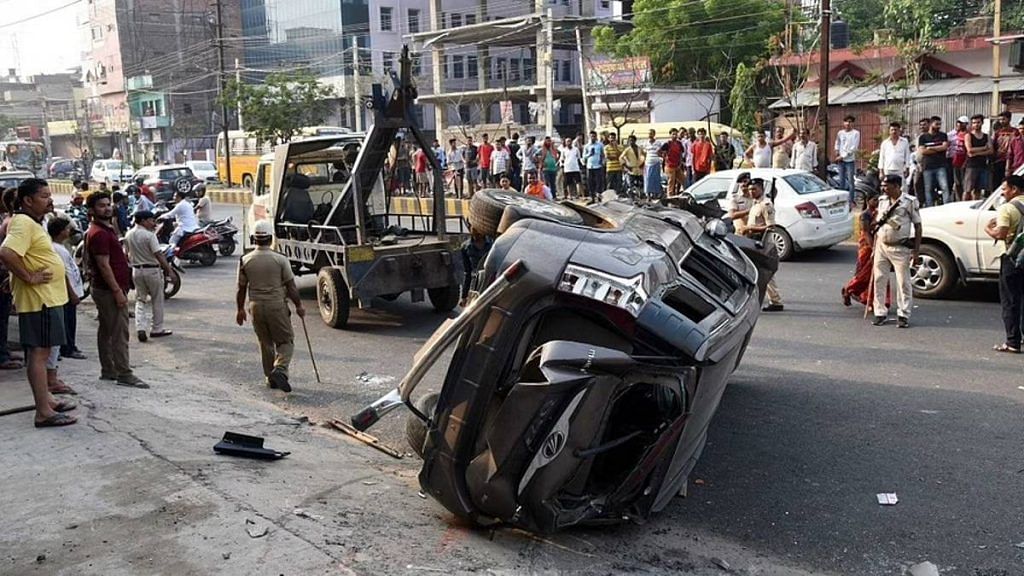New Delhi: A unified emergency number for reporting road accidents from across the country, a contest to encourage states to bring in innovations to improve road safety, and monetary incentives to states that push institutional reforms. These are among a host of measures the Modi government is initiating in collaboration with multilateral agencies to make Indian roads safer by 2028.
The measures are part of a $1 billion programme undertaken by the government to strengthen road safety, which the Union road transport ministry, with support from World Bank and Asian Development Bank (ADB), will implement in 14 states across India, senior officials in the road transport ministry told ThePrint.
The 14 states — including Andhra Pradesh, Gujarat, Odisha, Tamil Nadu, Telangana, Uttar Pradesh and West Bengal, among others — are those that account for 85 per cent of the total road accidents and fatalities in India, said Arnab Bandyopadhyay, World Bank lead transport specialist.
“The idea is to reduce road crashes and fatalities in these states by 30 per cent by June 2028,” Bandyopadhyay said.
He added: “This is a unique programme because it is the first time a road safety scheme is fully incentive-based… If a state achieves results then money gets disbursed among those states.”
While the World Bank on 27 June approved $250 million in financing — to support the programme in seven states — the ADB will give $250 million to implement it in the remaining seven states. The remaining 50 per cent of the fund will come from the Government of India, a senior road transport ministry official said.
ThePrint reached ADB over email for comment, but hadn’t received a response until the time of publishing this report.
India has among the worst road safety records in the world. While the country has 1 per cent of the world’s vehicles, it accounts for about 11 per cent of road deaths, according to a 2021 World Bank report. On average, one Indian dies every four minutes in road accidents, claims the report.
According to a 2017 World Bank study, India could potentially add 14 per cent to its GDP per capita if it brought down road fatalities and injuries by half.
Also read: Body & dash cameras for police — Modi govt’s new plan to keep roads safe, check ‘malpractice’
How the programme will work on the ground
According to Bandyopadhyay, the scheme has five pillars. The first is developing road safety infrastructure, where the maximum amount of money will be spent. Under this, the crash identification systems as well as black spots will be improved.
The second pillar is driver and vehicle safety. The two key areas of intervention under this will be to introduce automated driver licensing, and automated vehicle inspection systems. The third pillar involves improving enforcement, mostly through automation, and the fourth is strengthening the emergency response system.
To bring in institutional accountability, a fifth pillar has been introduced. This seeks to help promote a more coordinated management, creating space for non-state stakeholders and civil society to participate in the road safety management and also strengthening the data system and evidence-based intervention.
An independent verification agency (IVA) is being engaged to check if the states have achieved what they are claiming against various indicators. Also, whether the expenditure that is made to achieve those indicators complies with certain parameters that have been set under the programme.
The primary purpose of the programme, Bandyopadhyay said, is not only to reduce crashes and fatalities but also to strengthen the road safety and governance framework. The states have been given targets for every year and will get incentives for achieving them.
A unified emergency number
While the unified emergency number will be initially launched in 14 states, it will eventually be expanded to the rest of the country, said Bandyopadhyay.
Currently, unlike a unified police or fire helpline number, there is no single number to report road accidents in India. Different states use different numbers.
Bandyopadhyay also confirmed that the unified emergency number will be put in place in the 14 states will be put in place by 2026.
Post-crash interventions will also be strengthened under the programme. This will include increasing the number of ambulances, with a focus on states that do not comply with the World Health Organization’s (WHO) minimum standards for number of ambulances per lakh of population.
Secondly, more ambulances will be brought under the call centre across the 14 states.
“They will be GPS-fitted and will be managed by the call centre. So, that is quite an aggressive target. States, which are at 25-30 per cent [of ideal GPS-equipped ambulance strength], will have to take it to 75-80 per cent,” said Bandyopadhyay.
A ‘challenge fund’
Of the $500 million allocated to states by World Bank and ADB for bringing reforms and improving road infrastructure, if they are unable to use it or meet the target, the money will go to a pot or the “challenge fund”.
“It is highly unlikely that each of the states will be able to achieve all the targets, particularly the weaker states. So this money actually goes to a pot that the programme will run as a challenge fund for innovation,” said Bandyopadhyay.
The contest will be held every quarter, where best practices that states implement will be shared. The idea is that the states that perform well will influence the not-so-well-performing states or relatively laggard states.
The framework for the challenge fund will be decided in the next six months, said Bandyopadhyay.
He added: “Our expectation is that out of the total fund, about 10-15 per cent of the money will go through this competitive arrangement where innovation and best practices will be rewarded.”
(Edited by Poulomi Banerjee)
Also read: Indian drivers are experiencing a ‘myopia epidemic’ — large numbers just can’t see properly
